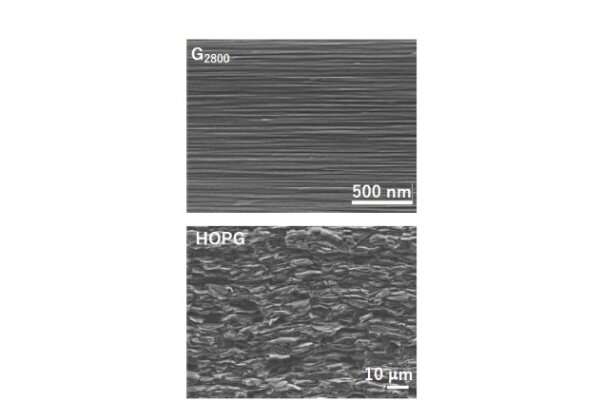Ultrasonic technique discloses the identity of graphite

A group of scientists from Osaka University, in cooperation with Kaneka Corporation, evaluated the interplanar bond strength of graphene by measuring the elastic constant of graphite, demonstrating that the elastic constant of monocrystalline graphite (Figure 1, top) was above 45 gigapascal (GPa), which was higher than conventionally believed. Their research results were published in Physical Review Materials.
Graphite consists of layers of graphene and the layers are bonded via weak van der Waals (vdW) forces, a ubiquitous attraction between all molecules. It was believed that the elastic constant of graphite crystal did not exceed 40 GPa.
This is because the elastic constants obtained from experiments using artificial highly oriented pyrolytic graphite (HOPG) were low due to structural defects in the graphite (as exemplified in Figure 1, bottom) and theoretical calculations also demonstrated that the elastic constant of graphite was less than 39 GPa.
Since a direct characteristic of an interplanar interaction is the elastic constant along the c axis of graphite, which reflects the interlayer bond strength, the elastic constant of graphite has been used to validate proposed theoretical approaches, and its accurate measurement is critical to thoroughly understanding vdW interactions.
In this study, Kaneka Corporation created a high-quality defect-free monocrystalline graphite by heating high orientation polyimide thin films at high temperatures; however, it was very difficult to measure the elastic constant of this crystal (10 μm in diameter, 1μm in thickness) along the thickness direction.
Thus, in order to experimentally obtain the elastic constant of graphite, using picosecond laser ultrasound spectroscopy, this group applied a laser of 1μm in diameter to the surface of a multilayered graphene for one 10 trillionth of a second to generate ultra-high frequency ultrasound. By accurately measuring the longitudinal wave sound velocity along the thickness direction, they obtained the elastic constant.
Although it had been thought that the interplanar bond strength of graphite was very weak, the results of this study showed that it had a strong bond strength: the elastic constant was nearly 50 GPa, which cannot be explained by conventional theories.
In this study, the short-range correlation effect selectively strengthened the potential energy surface (PES). This anharmonic PES enhanced the elastic constant of graphite. Using the ACFDT-RPA+U method, they demonstrated that the elastic constant reached 50 GPa due to the short-range correlation effect.
Lead author KUSAKABE Koichi says, "Our research group shows that graphite exhibits its superiority in a highly crystalline state. We have created high-quality, high-crystallinity graphite, which has stronger interplanar bond strength than previously believed. Applying ultrasonic measurement techniques to this defect-free monocrystalline graphite thin film will lead to the production of highly sensitive sensors for identifying biological matter such as proteins in non-destructive testing."
More information: Koichi Kusakabe et al. Interplanar stiffness in defect-free monocrystalline graphite, Physical Review Materials (2020). DOI: 10.1103/PhysRevMaterials.4.043603
Provided by Osaka University





















